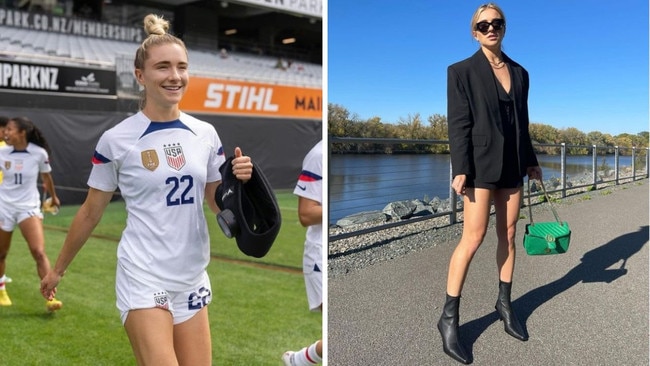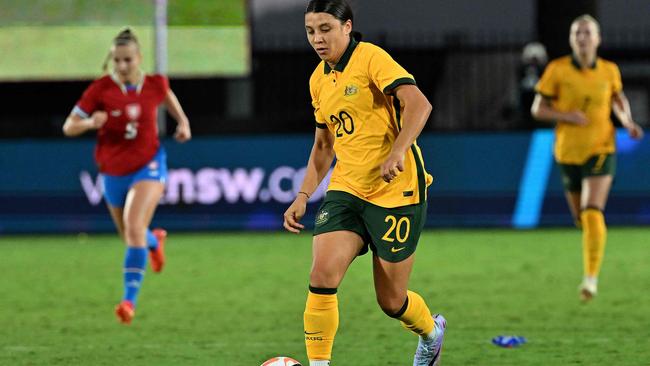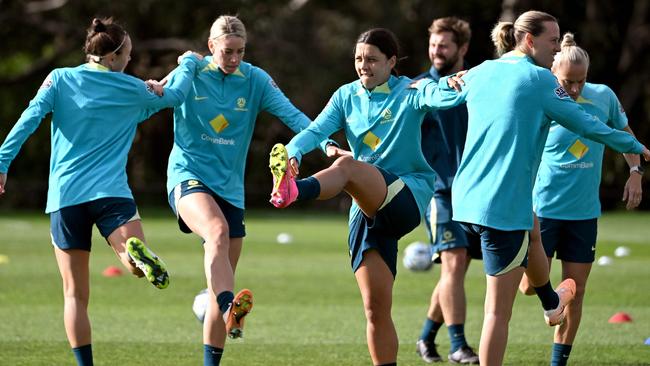‘Stinky and used’: Revealing photo exposes Aussie sexism scandal
Photos have revealed a wild issue that women are still dealing with in 2023. One that Aussie men don’t have to worry about.
Football
Don't miss out on the headlines from Football. Followed categories will be added to My News.
There is a particularly demeaning reason women’s participation in sport drops radically in late adolescence, and it has nothing to do with their willingness to take part.
Almost 100 per cent of female soccer players surveyed recently have been forced to wear “stinky used men’s uniforms” – an ugly precedent that has strangely carried through to 2023.
“They have been treated essentially as second class citizens,” said Sam Davy, Co-founder and CEO of sport brand PARK.
Women have had no choice but to accept the dregs of sporting kits designed for men, which for those who persisted with the sport, was an ongoing source of discomfort.
A survey conducted this year by Professional Footballers Australia found that 96 per cent of women players had been forced to wear men’s kit.
Women’s bodies change more dramatically and in different areas to men, Mr Davy said, which contributed to athletes leaving the sport because they felt self-conscious.
“Whether it be height or different types of body shapes, there’s lots of things from a clothing perspective that you’ve got to take into account,” Mr Davy said.

Of the women surveyed, many indicated feeling unvalued within their clubs because they never had access to appropriate kits.
“It made them feel not valued as athletes and there was lots of feedback around their clubs ordering kit and the men get first dibs and the women have to make the best of whatever is left,” Mr Davy said.
Among those to respond were women who had terrible experiences being disciplined for trying to make the men’s or unisex kit fit their body better.
“We were made to wear men’s cut in high school in our soccer academy and got in trouble if we rolled the shorts but because they were men’s fit they were way too long and were very slim fitting through the hips which was hard for any of the bigger girls,” one respondent revealed.

“We are biologically different [and] we should have [a] kit designed for us. I can’t believe some clubs still make their women wear men’s clothes,” another said.
“We got stinky used men’s uniforms. Felt like we were in sacks. Not a good fit and [a] bit demeaning considering the amount we paid to play,” a third shared.
It was an experience not unfamiliar to Young Matildas and Canberra United player Emma Ilijoski, who told news.com.au women players should have kit that fits them as a “bare minimum”.
“Kit can play a big role in your confidence and comfortability on the pitch,” she said, adding that she was “only really coming to terms with it now after dealing with it my whole life”.
She said not having a well fitting kit had taken the shine off her experiences getting selected for representative teams and “diminished the professionalism” of women’s soccer.
Players were forever needing to adjust the height of their shorts by rolling them up, which caused uncomfortable bunching, or had to contend with shirts that were too short, too narrow or too baggy.

Even professional players had to resort to rolling the top of their shorts over to create different lengths dependent how they fit their waist and thighs.
PARK, in consultation with top female players, has developed kit designed with diverse body shapes of women in mind in what it hopes will reduce barriers for them entering and continuing in the sport.
It was about two years ago that consultation begun for the development of women-specific kit as conversations around the historical inequity intensified.
“We felt it was a really important issue and set about solving it by working with athletes in our network,” Mr Davy said.
He noted other companies had made similar moves to include women, however not using a sustainable approach like PARK.
“All our fabrics are recycled content, our jerseys are made from seaweed fibres, we’ve removed all the toxic chemicals that other manufacturers put in to create moisture wicking attributes,” he said.
“We’ve replaced those with natural treatments like algae and different things that are not harmful for the environment or players’ skin, and perform well under different conditions.”
Keep the conversation going, email brooke.rolfe@news.com.au





